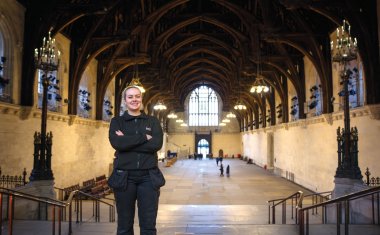The Archive of Serbia is now protected by Apollo
For a building that is both a historic monument and houses millions of records - mostly on paper- fire protection is of utmost importance. Fires in libraries and archives cause two...


For a building that is both a historic monument and houses millions of records - mostly on paper- fire protection is of utmost importance. Fires in libraries and archives cause two types of damage: material loss of the collections and perhaps the building and, social damage. Society has suffered some extraordinary losses from ancient times to the present, from the fire at the Alexandria Library to the fire at the Library of the Academy of Sciences in the former Soviet Union. Archives cannot be replaced. Once they have been destroyed, they are lost forever.
Opened in 1900, the Archive of Serbia is the country’s national archive, located in Belgrade. The current building was dedicated in 1928 to house and protect documents and other materials produced by state bodies and organizations of Serbia before 1918, as well as documents produced during and after World War II.
Although the National Archive was heavily damaged during World War II, the archives still hold a large amount of information dating back to early medieval times – over ten kilometres of historical records in 972 archives and 51 collections.
By definition, archives contain highly combustible materials like paper and cardboard. Tightly packed shelves positioned closely together accelerate the progress of any fire and even small amounts of smoke and soot can damage ancient and valuable documents. Water, used to extinguish the fire, can also cause a lot of damage. To avoid as much damage as possible, early warning fire detection is essential.
When called in to design, install and commission a new fire protection system for the Archive of Serbia, Apollo’s partner, TVI Ltd in Belgrade, specified Apollo’s XP95 optical smoke detectors and XP95 heat detectors.
Vladimir Zrnić from TVI said: “Designing a fire detection system for the archive was challenging and interesting at the same time. We knew that the air would not be completely clear and that rising temperatures had to be detected extremely early to avoid fire spreading rapidly as it would in a room filled with very old, and therefore very dry, paper.
“The XP95 Heat Detector from Apollo monitors temperature by using a single thermistor which provides a count output proportional to the external air temperature. The standard heat detector will report an alarm at a temperature as low as 55 degrees Celsius, whereas the XP95 Optical Smoke Detector works using the light scatter principle and is ideal for applications where slow-burning or smouldering fires are likely. Both are ideally suited for this project.”
Overall, more than 80 devices were installed covering ten software zones in the four-storey building. Fire suppression systems cover three floors of the four-storey building with an overall floor space of 5000m2.
Special considerations to be taken into account included the above average dust levels and very high ceilings. In combination with heating and ventilation systems, which can cause stratification, high rooms can be challenging for detection systems. A large number of high shelves were potential obstacles and could delay the detection of fire and smoke.
most read

Intersec Dubai 2026
Intersec 2026 expands to meet record demand and align with UAE’s vision for a safer future

Leonardo Enhances EU Border Security with Entry/Exit System Data Protection
Leonardo secures sensitive data in the EU’s new Entry/Exit System, boosting border control and cybersecurity

Suprema Paves the Way for Automated AI Security at SGPP 2025 Cancun
Suprema unveils AI-powered security at SGPP 2025 Cancun, redefining access control with cloud & video intelligence

Ping Identity Strengthens Defense Against AI-Driven Impersonation with Privacy-Preserving Biometrics
Ping Signs agreement to acquire Keyless, expanding privacy-first authentication across the entire user journey

Hochiki Fire Detection System Secures Villa San Carlo Hotel
Wireless and hardwired fire alarm systems can be specified in hotel projects that demand architectural sensitivity









